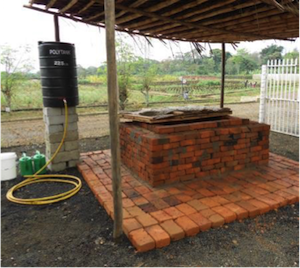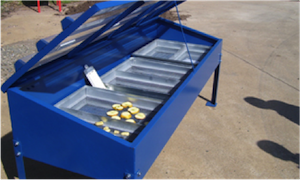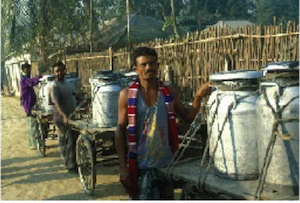Difference between revisions of "Addressing Food Loss and Waste - Examples"
(Published from sandbox) |
(No difference)
|
Revision as of 23:59, 5 June 2015
Contents
- 1 Example 1: Packaging innovations: Bags developed from fruit waste in Malaysia
- 2 Example 2: Packaging innovations: Edible food Packaging in Turkey
- 3 Example 3: Wakati
- 4 Example 4: Zero Energy Cool Chambers (ZECC)
- 5 Example 5: Dryers for Africa
- 6 Example 6: Rickshaws transporting milk in Bangladesh
- 7 Acknowledgements
Example 1: Packaging innovations: Bags developed from fruit waste in Malaysia
Scientists in Malaysia, on one hand, have introduced fruit waste-based plastic bags that could solve the degradable issue. The researchers at Universiti Sains Malaysia (USM) say they have developed FruitPlast by converting tropical fruit waste into flour, which is then fabricated into biodegradable plastic film. The plastic
manufactured from these fruits stands up in both tensile strength and ‘elongation at break’ level, compared with normal plastic wraps, according to the scientists. The bags, which naturally degrade in three to six months and last one to two years on the shelf, cost 10% less than the current non-biodegradable plastic bags commercially used. Featured in Packaging Gateway, May 2010 issue.
(Source: FAO, 2011-b: p. 19)
Example 2: Packaging innovations: Edible food Packaging in Turkey
The edible packaging material is a product of the Turkish Scientists research using more flexible film compared to competing products on the market. The flexible film is made using egg white and corn protein and natural substances and can kill microbes in food. The new packaging is 500% more flexible than those currently on the market, as claimed and will soon be produced three to four years hence. Featured in Packaging Gateway, May 2010 issue.
(Source: FAO, 2011-b)
| Packaging solutions for reducing food waste along the value chain | |
| Loss situation and causes | Selected packaging solutions |
| At production stage | |
| Unnecessary variety of packaging types | Universal packaging design |
| High amount of greenhouse gas (GHG) emissions per ton of production | Modified atmosphere packaging Integrated materials handling and warehouse management systems |
| Non-recyclable, wax-coated boxes for delicate perishables | Recyclable packages with excellent moisture barrier Reusable plastic containers |
| At post harvest stage | |
| Inefficient product insulation | Fibre reduction Microflute technology |
| Manual case forming and stretch wrapping | Automated processes reducing labour and material costs |
| Product spoilage and toxicity | Anti-microbial packaging |
| At distribution stage | |
| Damage due to palletizing, strapping | Slip sheets and stretch wrapping in lieu of pallets and strapping |
| Damage due to mixed products on pallets | Cube utilization via pin-wheeled position |
| At processing stage | |
| Damage during transport | Leak resistant packaging Tough, tear-resistant packaging |
| Product spoilage | Hermetic seals Vacuum or modified atmosphere packaging |
| Loss of production | Efficient equipment systems System integration and automation |
| At wholesale stage | |
| Inappropriate shipping containers | Optimizing secondary packaging for shipping and shelf impact/appeal |
| Damage due to high humidity, storage time and stacking height | Use of new materials with enhanced stacking strength Modified atmosphere packaging |
| At retail stage | |
| In-store preparation losses | Centralized food preparation In the bag merchandizing |
| Product spoilage | Leak-resistant packaging Vacuum or modified atmosphere packaging |
| Passed sale date | Shelf-life extension Freshness preservation |
| At consumption stage | |
| Too much preparation | Portion control packs Ready-to-eat entrees |
| Spoilage | Resealable packaging Vacuum or modified atmosphere packaging |
| Not consumed prior to expiration date | Shelf-life extension Freshness preservation |
(Source: Save Food and FAO, 2011: p. 12)
Example 3: Wakati
In poor countries, a large share of produce goods is lost before they reach the market, especially through the lack of cold chains for fresh vegetables and fruits. These products dry out wither and get rotten before they even reach their buyer. The Belgian ‘Arne Pauwels’ designed a solution, the ‘Wakati’, meaning time in Swahili. The Wakati is an affordable and clean technology for extending the shelf life of fruits and vegetables, especially in warm and humid climates. It is a solution that creates a concealed environment for fruits and vegetables that answers to their post-harvest needs and protects them from fungi growth. With approximately 1 liter of water a week, the Wakati keeps the products fresh, around 200 to 400 kg., depending on the crop. The Wakati is currently in a test-phase and will soon go to the market.
More information can be found on wakati.org.
Example 4: Zero Energy Cool Chambers (ZECC)
ZECC is a low cost evaporative cooling option. They can store multiple crops at one time and help farmers maintain water weight in their crops, reducing wilting and quality diminishment that hastens crops' decay and reduces marketability. It can be easily constructed with local materials.
Case study: Global Knowledge Institute, 2014 Foundation Food Waste and Spoilage initiative Resource Assessment_GKI.pdf Reducing Global Food Waste and Spoilage: p. 23
Example 5: Dryers for Africa
While most small scale farmers resort to open air solar drying, which is typically less efficient and unhygienic, there are other solutions. ‘Dryers for Africa’ distributes and sells solar dryers and forced air dryers. These extend shelf life for the year-round crops sale and consumption, reducing the risk of loss, decreasing the cost of storage and transportation, and they add price-enhancing value to the end product. The company has different types of dryers. Solar dryers require no electricity or specific skills (although literacy is advantageous and cheaper). They require only a secure sheltered location and access to clean water. Forced air dryers are more efficient, but more expensive and require electricity. The company sells products in multiple countries in Africa.
Case study: Global Knowledge Institute, 2014 Foundation Food Waste and Spoilage initiative Resource Assessment_GKI.pdf Reducing Global Food Waste and Spoilage, p. 25. More information can be found here: dryersforafrica.co.za
Example 6: Rickshaws transporting milk in Bangladesh
Rickshaws transporting milk from the countryside to processing plants in Baghabarighat, Banglasedh. Transporting milk in the warm and humid climate of Bangladesh without a proper cold chain may cause milk losses. The rickshaw transportation on narrow and winding roads prolongs the time milk is handled in warm temperatures.
(Source: FAO, 2011: p. 12)





